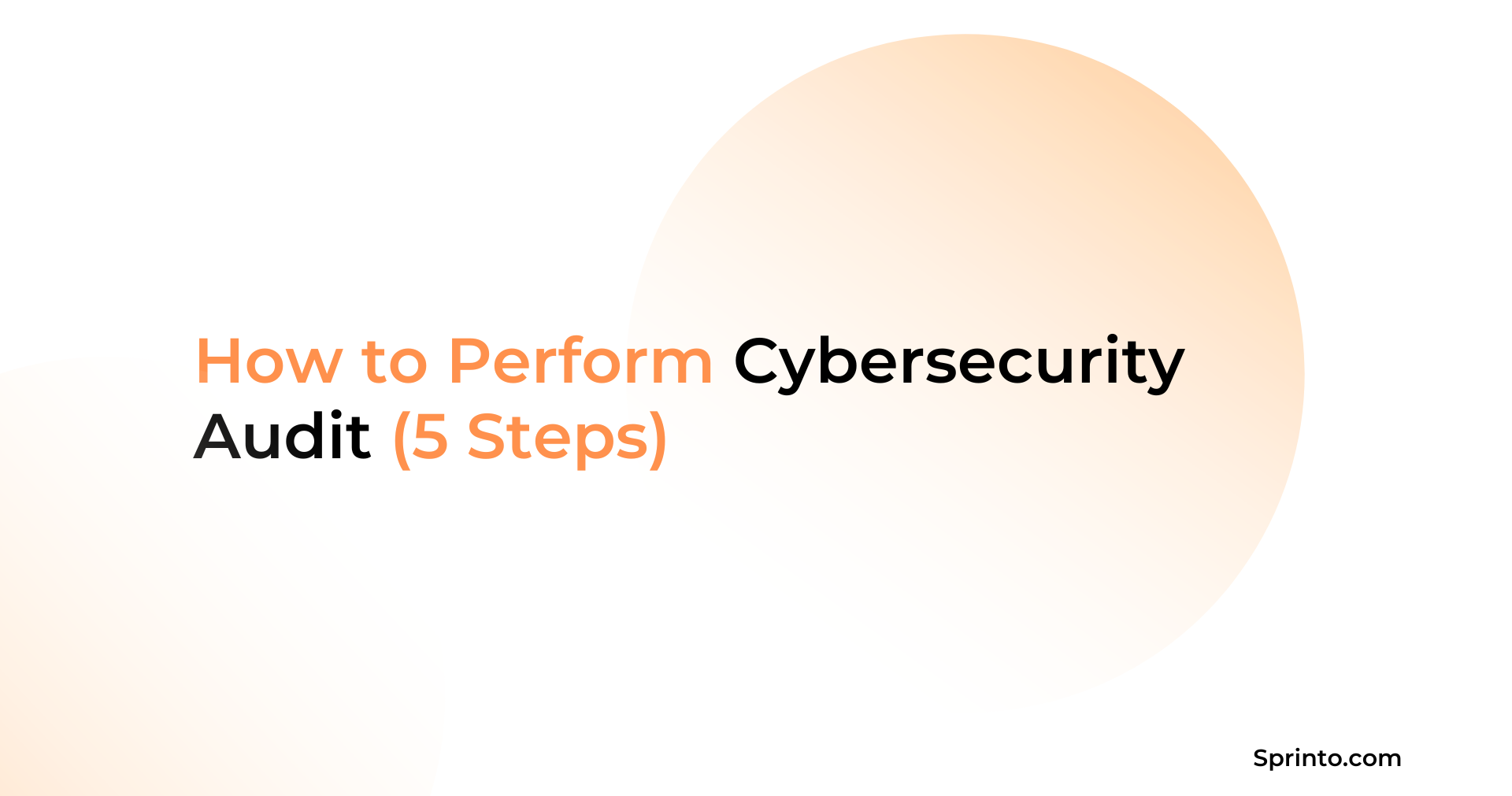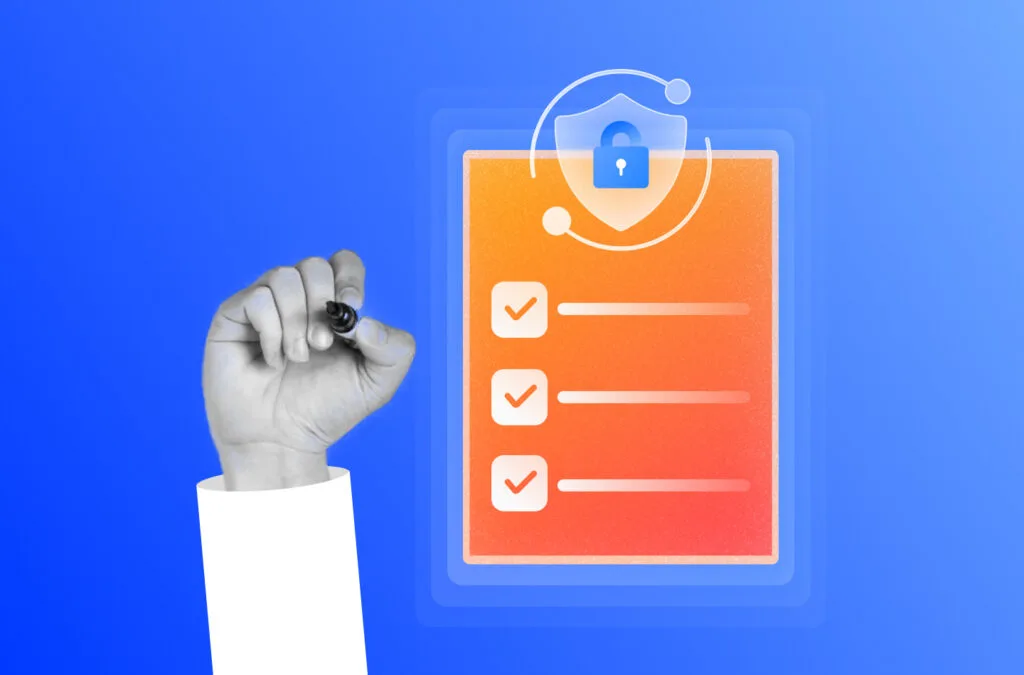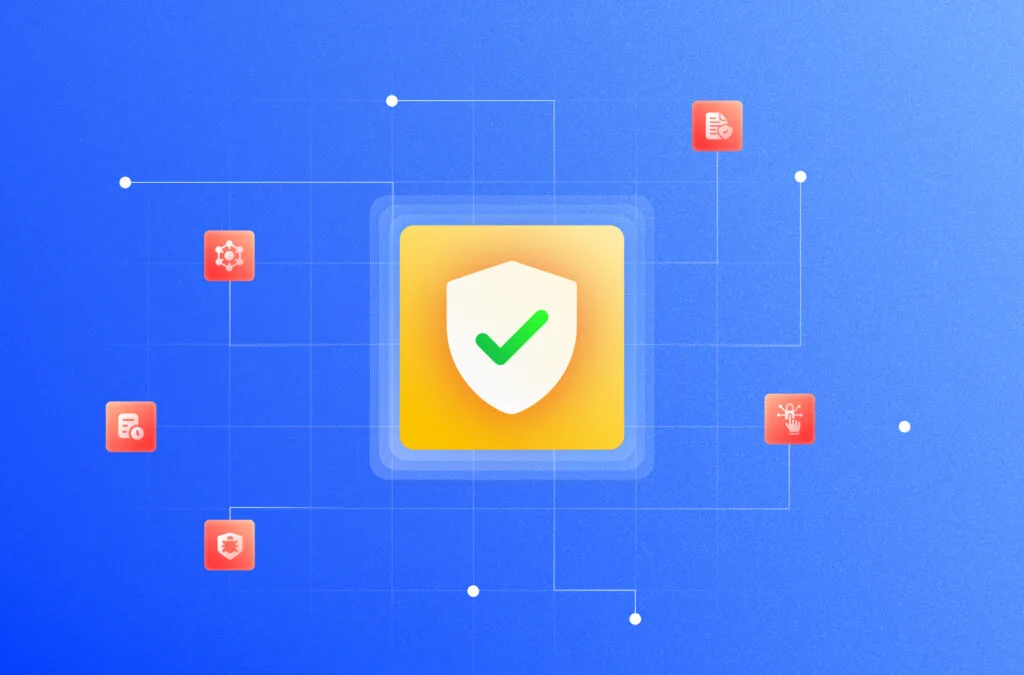Technology has made significant advancements in just the last decade as we went from smartphones to smart homes. We’re more connected than ever before but we’re also more vulnerable than ever before. Cyberattacks occur every 39 seconds on an average, affecting 1 in 3 Americans every year. That’s why cybersecurity has had a paradigm shift from “nice have” to “must have”.
The importance of conducting a cybersecurity audit cannot be overstated. A cybersecurity audit is a comprehensive assessment of your IT infrastructure, practices, and policies to ensure that they are protected against cybersecurity threats.
TLDR
| A cybersecurity audit is a systematic evaluation of an organization’s security measures, policies, and procedures to identify vulnerabilities and weaknesses that could be exploited by cybercriminals. |
| Conducting regular audits can help businesses proactively assess their cybersecurity preparedness and take necessary steps to strengthen their defenses. |
What is a cybersecurity audit?
A cybersecurity audit evaluates an organization’s IT ecosystem, compliance policies, and security practices to better understand its security posture and threat landscape. It evaluates the internal systems, network controls, physical security procedures, and other cybersecurity processes to identify vulnerabilities, assess risks, and provide actionable recommendations.
The goal of an audit is to understand your current state, identify weaknesses, and provide actionable recommendations for strengthening your security architecture.
What does a cybersecurity audit evaluate?
The scope of the audit involves evaluating these areas:
- The security of your network: How efficient are your firewalls, intrusion detection and prevention systems, and other security controls?
- Security measures taken to protect your data: How is sensitive data stored, processed, and transmitted? The audit examines data backup procedures, encryption practices, and loss prevention measures.
- Network access controls: What is your user authentication process? What are your password policies? The audit also looks into privilege management systems.
- Incident response plans: What are your incident response plans, and how will you ensure business continuity after an attack?
- Awareness programs and employee training: Have you trained your employees about cybersecurity, and are they aware of the cyber risks?
- Compliance standards: How compliant are you with relevant regulatory frameworks, laws, and industry standards?
A cybersecurity audit aims to identify cyber threats, vulnerabilities, and weak links in the existing network, assess risks, and provide recommendations to improve your organization’s cybersecurity posture. The information provided by these audits enables you to make informed decisions and allocate resources wisely to maximize the returns on your cybersecurity investment.
Want to know more about cybersecurity? What is Cybersecurity? Everything You Need to Know
Depending on the scope of your audit, you can either conduct it with your internal audit team or use an independent third-party auditor.
But what’s the difference between the two?
Internal cybersecurity audit
An internal cybersecurity audit is conducted by a company’s compliance team and other IT professionals to assess its cybersecurity posture. These audits focus on identifying vulnerabilities within the system and processes.
These audits are generally part of your company policy, which details the frequency, scope, reason, and other details. Management should ideally mandate an internal audit.
Benefits of an internal audit
- Internal audits raise awareness among employees about cybersecurity vulnerabilities and potential threats.
- It is a cost-effective solution that allows you to conduct cybersecurity assessments frequently.
- You can make strategic decisions based on the insights from the internal team.
Internal audits can also be used as a precursor to external audits. Sprinto’s GRC automation platform can be used to create an internal audit section that integrates with your existing infrastructure to run checks and understand your cybersecurity posture.
If you meet more than 90% of the requirements, you can go ahead with an external audit to get the stamp of approval.
Get a wingman for your cybersecurity audit
External cybersecurity audi
An external cybersecurity audit is a detailed evaluation of an organization’s security against cyber threats and vulnerabilities conducted by an independent security firm or qualified professionals.
External audits address the shortcomings of internal audits by bringing a range of tools, expertise, and unbiased opinions on a firm’s IT infrastructure.
Benefits of an external audit
- A successful external audit serves as a stamp of approval on your firm’s cybersecurity posture.
- The findings from an external audit are unbiased and demonstrate adherence to legal regulations, helping you mitigate fines and penalties.
Prepare for a cybersecurity audit in just a few simple steps.
Cybersecurity audits are an important part of maintaining a secure organization. Here are 5 steps for a successful cybersecurity audit:
Step 1: Understand the “why” behind the audit and define the scope
Start with an outline of the audit, gradually filling it in with more details. Here are a few questions that can help you understand your scope better (and document all of this)
- Why are you conducting the audit? Is it to assess the overall security posture? Is it to focus on a specific area of your network security?
- Do you want to do an internal audit or an external audit?
- What resources do you have and can allocate?
- What areas, if in particular, need to be audited?
- What is the timeframe of the audit?
- Who needs to be involved in this?
- Is this a mandatory audit, or did an incident occur that triggered this audit?
Your questions would be tailored to suit your organization, but this should be a good starting point. List out all the components will/ need to be audited, for example:
- Network security:
- Firewalls
- Intrusion detection/ prevention systems
- Wireless security
- Network access controls
- Security monitoring capabilities.
- System and data security:
- Operating systems security
- User access controls
- Data encryption methods
- Hardening processes
- Patching processes
- Privileged account management
- Role-based access
- Operational security:
- Cybersecurity policies
- Change management systems
- Anti-virus configurations
- Security procedures and controls
- Incident management
- Physical device security:
- Hardware security
- Disk encryption
- MFA
- Biometric data
After you realize the need for the audit, speak to the stakeholders. Communicate your reasons, get approvals, and keep them updated about this information. Understand that communication is not a one-time or a two-time activity. Keep an open communication channel to keep them engaged throughout the audit.
This is a great way to get management involved and make them understand the need for cybersecurity audits.
Step 2: Plan and prep
After you’ve received the go-ahead from the stakeholders, form a team and collaborate on relevant documents.
Here’s a list of documents you might need:
- Documents on security policies and procedures, such as incident response plans, data classification policies, acceptable use policies, and business continuity plans.
- Network security policies like the diagrams, firewall policies, etc.
- System documentation includes application security policies, access controls list, OS patch management procedures, etc.
- Gather any vendor security assessments, previous testing reports, or inventory of the assets, too.
Even though the number of documents can vary, the list is exhaustive, and you would want it
so. Cyber security does not happen by cutting corners or missing out on details. One error could have a catastrophic impact on your business.
Hence, it is best to automate this task. Automating evidence collection can save time and effort and streamline the process for auditors.
Automate 80% of your GRC tasks
Step 3: Assessing risks and identifying controls
Conduct a cybersecurity risk assessment to identify potential threats and vulnerabilities.
You need to identify potential risks that are specific to your business. Here are possible risk areas:
- Uncontrolled access to sensitive information
- Third party risks like breach of contract, unreliable service, etc.
- Inadequate security measures, like unpatched software with outdated updates, unsecure WiFi, etc,
- Absence of a formal incident response plan.
- Insufficient backup and recovery measures.
- Compliance risks like violations and infringements.
Each risk that is identified, is evaluated. Risks are assessed based on their probability and their impact on the organization, that is if the risk materializes.
You can use heatmaps or scoring systems to visualize the risks. This helps you better prioritize your threats and vulnerabilities.
The next step is to identify the effectiveness of the controls that you have in place. Let me break down how you can do that:
- Document all the controls you have, from technical controls like firewalls and encryption to adm like policies and procedures.
- See if your control set up directly addresses the risks that you have identified. For example, if you have identified insider threat as a risk, ask yourself a few questions… Do your current policies address them? Do you need to update your documents and procedures for the same? How well are your employees understanding the current policies and procedures?
- For technical controls, you will have to run scans and tests like vulnerability scans and penetration testing to test your network’s defenses.
- Identify any areas that your current controls cannot assess. For example, do you have controls in place to protect sensitive data stored on mobile devices? Are there any weaknesses in the implementation of your controls? Are there protocols in place to promptly repair vulnerabilities?
Step 4: Document the entire process and have follow-up plans in place
Write up your conclusions in an audit report. The technical language needs to be broken down into manageable steps. Throughout the process and at the conclusion, you need to record the following things:
- Jot down every threat and vulnerability that has been found, along with the systems that are impacted, the extent of the breach, and the business impact. This will assist you in setting priorities for your future remedial work.
- Recognise the risks you have evaluated, the possibility that they will recur, the steps you took to reduce their impact, and the possibility that these dangers will be exploited in the future.
- Additionally, record any noncompliance issues that you discover.
Once you have all of this information jotted down, provide a detailed overview to your board. Discuss the follow-up plans with them and a realistic timeline for addressing the identified risks and implementing the recommendations.
Step 5: Evidence collection and implementation of the Incident response plan
Implement centralized evidence collection from all critical systems and applications. Ensure that they capture relevant details like user activity, system changes, access attempts, etc.
These logs are typically maintained for 12-18 months, or as required by the applicable regulations.
You can implement measures like write-once storage or digital signatures to prevent them from being tampered. You can leverage technology to automate continuous test controls and flash anomalies.
Maintain an audit trail of evidence, retention policies, and review procedures. This comprehensive record-keeping will not only support your audit readiness but will also act as a catalyst for implementing the incident response plan.
Implement the incident response plan. The IRP will involve patching software and strengthening your cybersecurity architecture using firewalls or intrusion detection systems. Segment your network structure to limit the spread of any cybersecurity breaches.
Ensure that you have clear guidelines on data restoration processes. There isn’t a clear turnaround time for when you should bounce back, but ensure that you are resuming essential operations with minimal downtime.
This sounds exhausting, right? You must be wondering…..
How frequently do I need to undergo a cybersecurity audit?
Conducting regular cybersecurity audits helps you mitigate potential risks and strengthen your security posture. Moreover, they also ensure compliance with industry regulations. Internal audits and external audits are conducted at different intervals.
Ideally, internal audits are more frequent and they help you gear towards an external audit. External audits are usually mandated by the compliance regulations and laws applicable to your organization.
Here are some factors that affect the frequency of an audit:
- Industries: Organizations in industries like finance and healthcare may have to conduct audits more frequently as they have sensitive information that, if leaked, could prove catastrophic not just for the business but for everyone else involved.
- Regulatory requirements: Certain regulatory frameworks are necessitated when the audit for that framework needs to be conducted.
- Changes: If your organization is undergoing a change, like a merger or acquisition, or you are onboarding new third-party vendors, you would need to conduct these audits frequently.
- Security incidents: If you have experienced any threats or even a near miss, you might want to increase the frequency of your audits, even temporarily.
Some focused tests, like penetration or vulnerability , should be conducted more often than certification audits.
Find success with these best practices for cybersecurity audits
Some of the best practices for conducting an audit include:
- Engaging stakeholders and departmental heads from different areas of the organization to ensure that you have a comprehensive understanding and a unison buy-in to the process.
- Refer to framework documentations that are applicable to your organization to guide your audit process.
- To ensure objectivity in the audit, ensure that there is no overlap between the auditor and the area of responsibility.
- Keep a detailed record of everything, as it helps in analysis. Doctors also practice a general rule of thumb: “If” you ever find yourself in the weeds, go back to history. Trace every route you took and every route you did not, and question your choices.”
- Automate as much as you can. While you cannot automate audits, you can automate steps that lead up to an audit like evidence collection, maintaining logs, control testing, risk assessments, etc. Audits are labor-intensive and exhaustive; you don’t want anything slipping through the cracks.
- Review your previous audits. Identify any security weaknesses and ensure that this weakness is not exploited again.
Can Sprinto help?
Managing cyber risks involves continuous risk assessments, implementing and testing controls, and maintaining comprehensive documentation. Everything with GRC is an ongoing process, making it an exhaustive one, especially if done manually.
Sprinto as a GRC automation tool can significantly reduce the time it takes to get audit ready. It automates 80% of your GRC tasks. Here’s how Sprinto helps you:
- Continuously monitors risks across all systems and endpoints.
- Sends you real time alerts to prevent risk escalation.
- Offers a centralized dashboard for a holistic view of your posture.
- Offers pre-configured security policies to address common gaps.
Sprinto enhances your overall security posture and eases the burden when it’s time to prep for an audit. Instead of scrambling to gather evidence and demonstrate compliance, you can have a well-organized, continuously updated record of your compliance posture and risk efforts at your fingertips.
Breeze through your cybersecurity audit
FAQs
What is a cyber security audit?
A cybersecurity audit systematically evaluates your IT infrastructure, policies, and procedures, like firewalls, intrusion detection services, and incident response plans, designed to protect your digital assets from cyber threats and attacks.
How do I prepare for a cyber security audit?
To prepare for a cybersecurity audit, here are a few things to keep in mind:
- Review all your security policies and procedures and check if they need to be updated.
- Gather important and relevant documentation, like disaster recovery plans, incident reports, network diagrams, asset inventories, etc.
- Ensure that your systems are up to date.
- Prepare your staff for any potential interviews.
- Review previous audits, analyze the auditing process, and understand the actions taken.
What is the difference between an IT audit and a cyber security audit?
IT audits cover a wide range of IT operations, whereas cybersecurity audits focus on security aspects. IT audits often emphasize compliance with internal policies, whereas cybersecurity audits focus on the organization’s ability to assess, prevent, and respond to threats.
How many types of cybersecurity audits are there?
There are different types of cybersecurity audits:
- Internal audits conducted by internal auditors
- External audits are performed by independent third-party professionals.
- Application security audits that focus on software applications’ security.
- Network security audits that examine the security of the network infrastructure.
- Physical security audits examine physical security measures and access controls to IT assets.
- Incident response audits evaluate the organization’s ability to detect and respond to security incidents
Heer Chheda
Heer is a content marketer at Sprinto. With a degree in Media, she has a knack for crafting words that drive results. When she’s not breaking down complex cyber topics, you can find her swimming or relaxing by cooking a meal. A fan of geopolitics, she’s always ready for a debate.
Explore more
research & insights curated to help you earn a seat at the table.






















